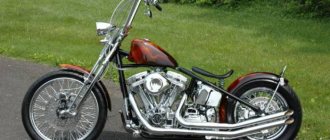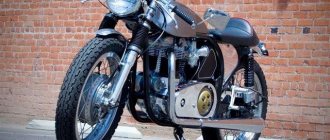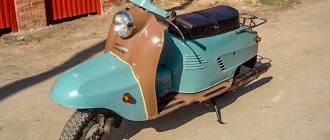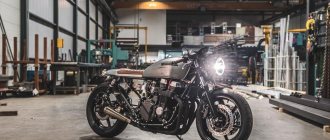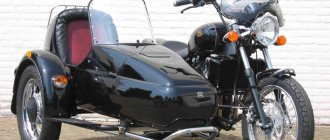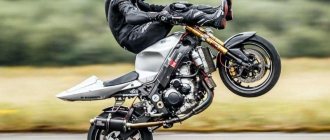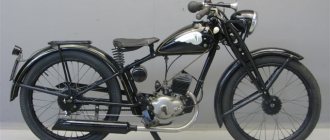Cafe racer style motorcycles appeared in the UK a long time ago, back in the 60s of the last century . Now they are not very popular, so their army of fans is modest, but devoted, and it is this that does not allow this class of bikes to disappear. Retro technology has never been particularly popular, so there are actually no serial café racers produced now. However, thanks to customizers, unique bikes end up on the roads, many of which look like works of art.
Origins of style
About 60 years ago in Great Britain, particularly in London, local motorcyclists began to gather in bars, pubs and cafes, while having fun racing to the accompaniment of music. London's most famous gathering place was the legendary Ace Cafe , which, by the way, is still in operation today. A fairly short straight road led away from it, on which the race participants tried to accelerate to maximum speed . They considered the highest achievement to be “doing a hundred,” that is, accelerating to 100 miles per hour, while managing to brake before the end of the road. Considering that in that era the engines were already quite powerful, and the brakes and suspensions remained extremely primitive, few could do this, and everyone who managed to “make a hundred” enjoyed immense respect.
Cafe racers got their nickname precisely because of these races near the Ace Cafe - other motorcyclists contemptuously called them “ cafe racers ,” hinting that they had nothing to do with real racing. However, they readily took up this nickname, which over time lost its negative connotation and became a source of pride, and later turned into the name of a class of motorcycles. As the years passed, the English racing subculture gradually disappeared, but its legacy lives on to this day.
Motorcycle modifications
Among the British rockers of the fifties, the most popular were road motorcycles of the brands Triumph, Norton, BSA, and less often Vincent. The point of all their discussions came down to what speed these machines were capable of developing - of course, a racer on a production motorcycle (on a machine that came off the assembly line, that is, without additional modifications) would never “make a ton” (from the English “do the ton”) " - make a ton, reach a speed of 100 mph = 160 km/h).
Most often, guys turned to professional motorcycle racers for special parts for their motorcycles that could only be found on sports bikes. Thus, riders on almost racing motorcycles rushed headlong through the streets of London.
Of course, the modifications were not limited to external changes - on the contrary, the engines underwent very serious technical modifications. The guys on motorcycles were, as a rule, not rich, which, however, did not stop them from creating such works of garage art as the Norvin - a Norton frame and a Vincent engine.
In those years, auto racing became widespread, and athletes often borrowed Norton Manx motorcycle engines for their formula racing. And due to the fact that Norton did not sell engines separately, motorsports athletes were forced to buy entire motorcycles. The excellent chassis (featherbed frame, wheels, etc.) were sold to fierce guys who installed obscenely powerful two-cylinder engines from Vincent Black Widow in these frames. The result was a motorcycle that was radically different from the standard one, sharp to control, lightweight and powerful. Tritons (Triumph engine in a Norton frame), TriBSA (Triumph and BSA) and much more were born in a similar way.
This is approximately what a set of parts for building a proper cafe racer motorcycle looks like: 1. mechanical instruments the size of saucers, preferably Smiths, Veglia and even aristocratic Jaeger; 2. single saddle with a characteristic round “hump”; 3. bikini - a semi-fairing in the form of a cap covering the headlight; 4. clip-ons (handlebar halves mounted on clamps on the fork legs) - for greater cornering speed and, of course, a race-look; 5. “rear” footpegs - driver’s footpegs and levers moved back; 6. elongated tanks - not long, but rather elongated, looking as if an additional volume was attached to the back of an ordinary drop- or egg-shaped tank - in fact, pure foppishness and imitation of “real racing” vehicles, which then ran not on gasoline, but on low-calorie, high-octane hellish mixtures of acetone, alcohol, benzene and God knows what else.
Peculiarities
A typical coffee bike, that is, a cafe racer-style motorcycle, looks like a stylized racing bike from the mid-20th century. The kafeshnik presupposes a bullet-shaped fairing, a semi-recumbent seat, the absence of a passenger seat (usually some kind of plug is installed instead), an abundance of chrome and a general appearance consistent with a bygone era. Many companies produce tuning designed to turn your steel horse into a cafe racer, but it usually costs a lot.
The cafe racer motorcycle can be built on the basis of almost any donor. Some Honda or Yamaha is taken, disassembled to the point of “frame on the slipway, engine in the corner, spare parts in bags” and rebuilt until it begins to meet the tastes of the owner. The source of inspiration is usually photos borrowed from the Internet, of which you can find many thousands if you wish. The final result directly depends on the available budget, the owner’s sense of taste and the radius of curvature of his hands.
What is a cafe racer
A cafe racer is a bike that has been modified by its owner in a special way to achieve high speeds and precise handling on winding and narrow city streets.
Of course, there is no need to talk about comfort in this case. The term “cafe racer” is used to refer not only to the motorcycles themselves, but also to their owners. I would like to immediately note that these motorcycles are not “custom” in the full sense of the word, but converted from serial ones with an eye on racing cars. Short, low-mounted clip-ons mounted under the top yoke and high-mounted footpegs create a sporty riding position, while the long fuel tank allows the rider to rest on it, reducing airflow resistance.
In the sixties, cafe racer tanks were often handmade from aluminum. Later, in the seventies, long aluminum tanks were replaced by narrow and short fiberglass tanks. Racing style fairings, when fitted, were attached directly to the frame. Everything that was not directly related to the control of the motorcycle was thrown into a landfill for the sake of weight reduction.
Current state
Serial cafe racers are not produced by any company, although some of them produce models vaguely stylized as bikes of this class. Even Chinese motorcycle manufacturers are making some attempts, for example, the Stallion brand, which is actively supplying its small-capacity motorcycles to many Asian countries. But custom custom ones a la cafe racer invariably appear at various motorcycle exhibitions, where they often take prizes. The famous custom Honda Cafe Racer, for example, has traveled with its owners to more than a dozen countries.
If you want to join the small but persistent ranks of café racer lovers, it’s a small matter. First, decide on a donor model, and it can be a road motorcycle, a cruiser, or a sportbike. Estimate an approximate budget, multiply it by two, taking into account the inevitable nuances that did not occur to you at this stage, develop the design of the bike of your dreams and get started. Who knows, maybe you will be the one to build a custom that will take first place at prestigious exhibitions?
Workshops
Today, in the wake of the fashion for retro motorcycles, workshops are appearing that are capable of building cafe racers, trackers, bobbers, and so on, with an eye to the canons and principles of construction, as well as taking into account modern trends. There are many workshops in the capital that can realize even the most daring ideas in construction: Fitil DMC, POMERLYANmotorcycles, Techmoto | 53. The latter have built several interesting projects - these motorcycles have appeared on the pages of reputable motorcycle publications and often appear on the city streets.
The average price tag for building a modern turnkey cuff bike ranges from five to eight thousand euros, which is incomparably cheaper than similar offers from the world famous Deus and Wrenchmonkees. And even more so, cheaper than the new-made, but essentially fake factory Triumph Thruxton.
More or less cubic capacity motorcycles (with a large engine capacity) should be considered as a template for a cafe racer. A cafe racer who can’t “do a ton” is a joke. These models are ideal for construction (average prices for them rarely exceed 170 thousand rubles):
History of cafe racers.
Café racers originated in the UK, where they were raced on the ring roads of London. The most popular route was a circle from the Ace-cafe along the Northern Circular Road to Hanger Lane and then back. The goal of the rides was to go the distance and be back before the jukebox finished playing one song. It must be said that it was necessary to drive all the way at a very high speed, since the Rockers listened mainly to Eddie Cochrane and Elvis, and the tunes rarely lasted more than two minutes. In essence, young people simply organized street races on motorcycles against the clock.
Then, already in the late 60s, the café racer movement and this type of racing spread throughout Europe, and were popular in Germany and Italy.
One of the racing goals was to reach 100 mph (160 km/h), which in rocker lingo was called "making a ton."
It is noteworthy that before the war, motorcycles were more a means of transportation than racing equipment, but after the war everything changed. Veterans of the Second World War needed a sip of adrenaline, and the younger generation had solid rock and roll in their heads. In addition, after the war, people had some savings that were spent on buying motorcycles.
In the late 1960s, British legislation tightened and London's road system underwent significant changes. Cars became much more affordable, and those who previously used a motorcycle as their main transport switched to four wheels. Public opinion had a great influence on the extinction of the Rocker subculture and the end of street motorcycle racing. Rumors of bloody biker showdowns spread across the sea; in Britain, the Brighton Massacre took place - a large-scale clash between Rockers and Mods. There were fewer and fewer rockers, and then the much more massive hippie movement drove the last nail into the coffin, converting most of the rockers into its ranks.
Rockers as a subculture have ceased to exist, but the cafe racer style of motorcycles is still very popular. Next - about the technical features of cafe racers.
Domestic motorcycle industry
Beginner motorcyclists often try to build a cafe racer from inexpensive IZHs and Yavs, but nothing good comes of it, as a rule, due to the low reliability of these motorcycles, as well as their utilitarian nature. And there is no historical reason for building a cafe racer from a domestic motorcycle, since there were no such motorcycles in the USSR.
Motorcycles from the Irbit Motor Plant (known under the Ural brand) are now increasingly being exported to the USA and European countries, but for local connoisseurs they are interesting only in their authentic form, with a sidecar - that is, as heavy pre-war motorcycles.
Story
The history of cafe racers began in the first half of the 20th century and is closely connected with the roadside Ace Cafe on the Northern Ring Road outside London, which opened in 1938 and was restored after the Second World War in 1948. In the post-war period, there were interruptions in transport and fuel - few cars were produced, gasoline was sold in limited quantities. Motorcycles have become an alternative to cars. Those who could not afford a new device bought a used one. For example, a decommissioned police motorcycle was then selling for just £65. The motorcyclists spent their evenings in the Ace Cafe discussing, comparing and heatedly arguing about the devices they had assembled.
The 1950s-1960s were the golden age of this cafe. Motorcycle sales have peaked. On a regular weekend, up to two or three hundred bikes could be counted in the parking lot in front of the establishment, and on days when some event was celebrated, up to three thousand. Despite the superhuman efforts of the police, the road passing by the cafe turned into a racing track.
In that era, a phenomenon was born that later turned the whole world upside down - the era of rock and roll broke out, and Ace Cafe found itself at the center of events. At first, crowds of people on motorcycles came to watch on TV (this was also a rarity then) concerts of “King Elvis” and other stars, and later rock bands, attracted by the huge crowd of spectators (that’s exactly what happened, and not the other way around), began to play in the walls cafe live. Soon, young men on bikes, clad in black leather with steel studs and chains, began to be identified with rock. So history brought out a new breed of motorcyclists - rockers.
However, not all young people accepted the rockers' lifestyle. The fashions that emerged in the same era sported expensive suits and therefore preferred motor scooters (now scooters) rather than motorcycles. For their fashionable outfits, sleek hairstyles and arrogant demeanor, they were nicknamed mods. It’s not hard to guess that relations between rockers and mods were strained. And the cafe area often turned into a battlefield. The newspapers were full of headlines: “Twenty people arrested in a new fight between rockers and mods,” “Death to the mods!” his tattoo read.” More than a thousand people sometimes took part in street battles. And this whole culture of motorcycle rockers was inextricably linked with the café racers that were then popular among them.
Nowadays, cafe racer owners are still a fairly large segment of the London motorcycle community. Cafes and taverns, where motorcycle people usually gather, are still enviably popular among them. Any English motorcyclist will immediately name Matlock Bath, Cat and Fiddle and another dozen and a half similar eateries.


